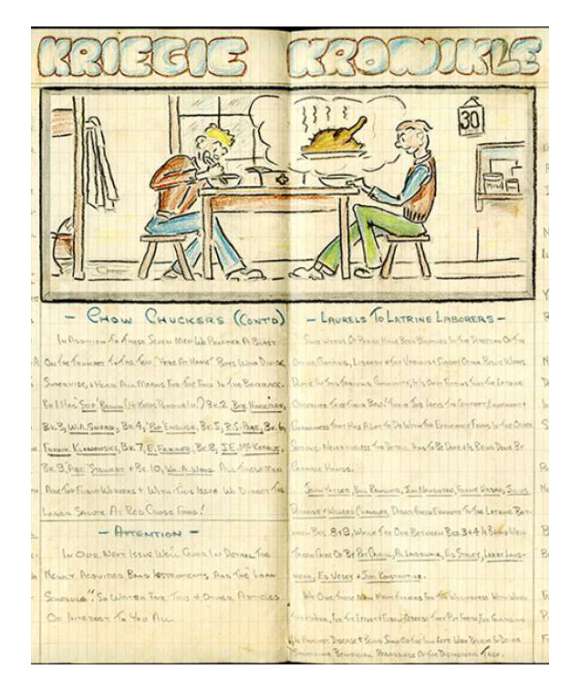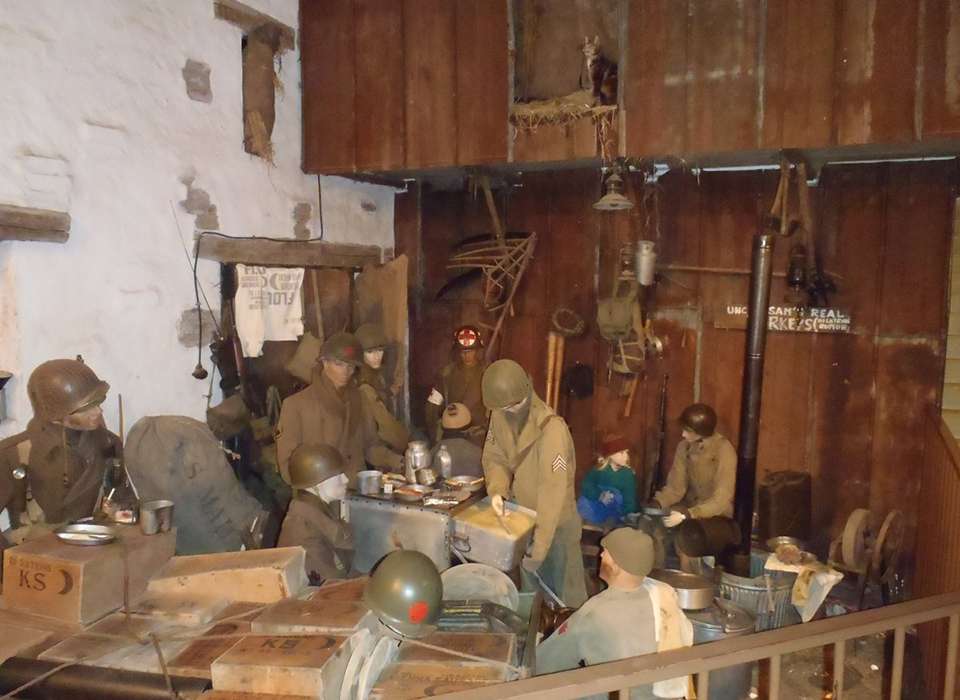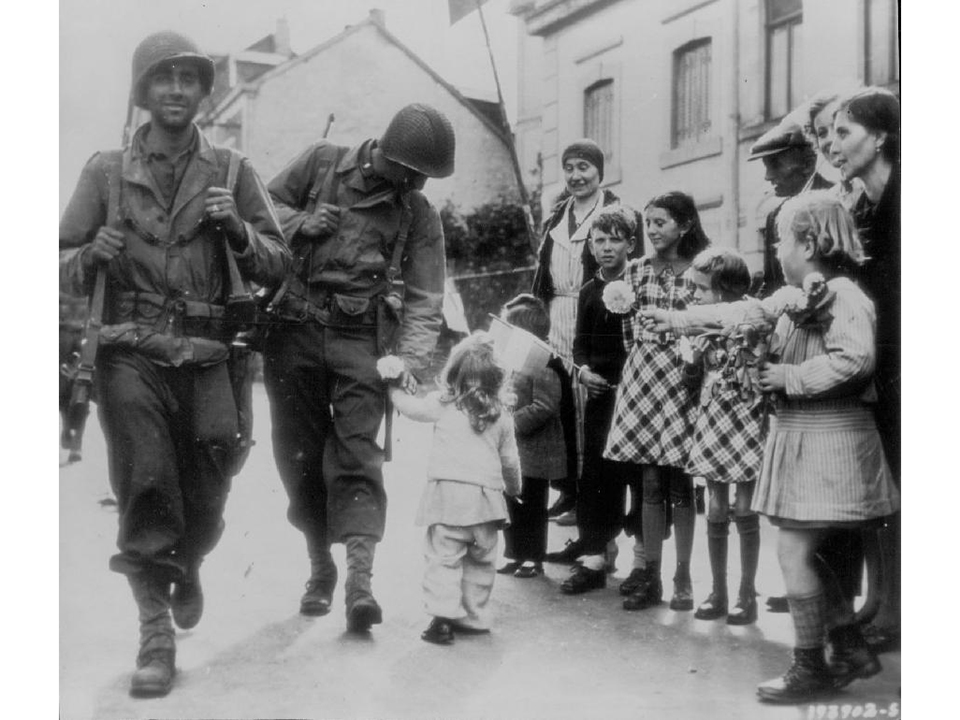Top Image: Thanksgiving Diorama at the Luxembourg National Military History Museum.
To commemorate Thanksgiving, we asked our friend Roland Gaul to write about the unique experience that American GIs and Luxembourg civilians shared during November of 1944. Gaul has been involved with the Museum since we began leading our own educational tours of battlefields across the world, and the The National Museum of Military History Museum, which he helped establish was one of the highlights of that, and subsequent visits to the Ardennes.
Shortly after its initial liberation from an almost four-year nightmare by American forces in September 1944, the Grand-Duchy of Luxembourg soon thereafter became a rest and recreation and billeting area for numerous US units that badly needed a respite from combat operations. Thousands of GIs were temporarily stationed or transferred to Luxembourg to rest, restore their morale, allow them some free time, and enjoy hospitality from grateful Luxembourgers, all while their decimated units were being rebuilt by a steady stream of reinforcements arriving from the United States. Their equipment was brought up to snuff again, and their combat readiness was reconstituted during that time. The grateful nation of Luxembourg, newly liberated from Nazi oppression, warmly welcomed its American liberators. Needless to say, all the GIs greatly appreciated this spontaneous demonstration of genuine gratitude despite the language barrier—to them Luxembourg soon became the “paradise for weary troops.”
A fair number of those US troops were stationed in the north and east of the country bordering with Germany, where they were billeted in many Luxembourg farming villages and small towns. A number of different units rotated through the area during the war. Around November 20, 1944, battle-fatigued troops from the 28th US Infantry “Keystone” Division arrived from the area south of Aachen, where they had experienced a considerable number of casualties in the bloody and costly battle of the Huertgen Forest. They moved into positions and quarters that had been occupied by units that preceded them along the Luxembourg-German border overlooking the Our river. They were actually facing the “Westwall” or “Siegfried line.”
As they were now billeted again primarily in villages, rather than in uncomfortable and often leaking tents, there was frequent contact between American GIs and the local villagers. Despite language problems, the locals were happy to host their “American liberators” and went out of their way to make American soldiers’ stay as pleasant as possible by inviting the them into private homes, volunteering to assist the GIs with things such as clothes repair, and offering the Americans local food and drinks. With the US liberation of Luxembourg, a bit of American culture and “lifestyle” came to Luxembourg. The music that was “forbidden” for four painful years was soon heard from gramophone records, played everywhere by the GIs during their off-duty hours! Baseball became omnipresent and numerous farmer boys soon learned how to handle a bat. In addition, US food products, primarily canned food, the so-called “C” ration cans that numerous GIs gave to the villagers in exchange for small services such as “laundry washing,” rapidly gained popularity. Food products like corned beef, vegetable hash, potato flakes, spaghetti and meatballs in tomato sauce, dehydrated powdered eggs, soluble coffee—you name it—brands like Spam, Kellogg’s, and Pilchards soon found their way to locals’ tables as easy-to-make supplementary food. Of course, the ubiquitous chewing gum and “Hershey” bars were cherished by the village children. Chocolate and chewing gum, by the way, became the first two words of English even toddlers picked up very quickly.
Although in late fall of 1944 there were no more combat actions in northern Luxembourg, the understrength units of the 28th Infantry Division held a thin line of defense and were always on the alert. The reconnaissance patrols tried to collect information on the enemy situation across the border, marked by the Our river. Occasionally at night enemy artillery fired a few rounds into US-held Luxembourg territory, which were usually answered by American guns. From time-to-time patrols clashed with each other and bursts of automatic weapons could be heard. But all in all, it was very quiet in late November of 1944, which added to the general and overall belief that the war would end soon.
The end of November customarily marks the Thanksgiving holiday in the United States, and to the GIs in Europe, thousands of miles away from home, the news that the traditional turkey dinner would take place “on the frontline” became a powerful morale booster and a sentimental bridge to their loved ones back home! For their Luxembourg hosts and friends, this was something totally new, never seen, never experienced before in the country. The villagers could hardly believe their eyes when GMC trucks pulled up and mess sergeants distributed live, or frozen, turkeys to the various mess halls and field kitchens, along with cans of cranberry jelly, flaked potatoes for mash, and other ingredients. All day long the “chefs” were frying turkeys in their gasoline-operated field stoves and the smell of freshly-cooked turkey soon filled the air! The hungry GIs enjoyed their turkey dinner and servings as prepared in the local units’ field kitchens. They ate their traditional “Thanksgiving Dinner” out of their mess kits in tents or in the barns. They entertained the Luxembourg families and villagers and got themselves “entertained,” for example with “Quetsch,” a strong local booze distilled from plums. Truly, a piece of home in the GI mess kits on the frontline, provided by Uncle Sam.
Thanksgiving Day 1944 resulted in an early, successful American-Luxembourg socio-cultural event, which is still recalled by many senior Luxembourgers today.
Front-line artists toured the villages and gave barn or jeep shows, playing guitar, singing and playing the newest musical records from the United States. Occasionally, larger tents were put up for front-line movie theaters and many village boys “sneaked in” to watch “Wild West” movies. In larger towns, the USO shows entertained the soldiers—it was announced that Marlene Dietrich would make an appearance in December of 1944. Again, all of those recreational activities, while still on the alert, gave hope for a rapid end to the war, as everyone gradually adopted the mood of the approaching end-of-the-year festivities…perhaps a Christmas in peace. The “ghost front” around Thanksgiving Day was quiet—very quiet, indeed!
Needless to say, many friendships formed between GIs (many of them farmer and country boys themselves) and the villagers. Addresses were exchanged, photos shown, and language barriers were overcome by borrowing interpreters like the village teacher, the priest, or by GIs with a basic command of German or French. Often body language helped too.
Yes, the Luxembourg townspeople and villagers were totally amazed and pleased by Thanksgiving Day. Glenn Miller’s tunes just added to the overall atmosphere. Unfortunately, the German surprise attack on December 16, 1944, known as the “Battle of the Bulge,” disrupted those dreams and thousands of GIs became casualties. About 60 percent of the north of Luxembourg was destroyed.
After the war, Thanksgiving Day, as well as Halloween, slowly made its way into the local customs and yearly calendar. Many Luxembourg families, remembering the “November 1944 Thanksgiving Day,” adopted that custom. As turkey was generally not widely kept as a fowl in Luxembourg, goose was substituted for the traditional “turkey” dinner along with gravy, occasionally buttered corn-on-the cob, and mashed potatoes. Only on Christmas Eve, wealthier families in larger cities had “turkey” or “dinde” (in French), an adopted French custom. Cranberry jelly or sauce took a little longer to be “accepted.” Gradually, and certainly with the establishment of the first supermarkets in Luxembourg in the 1970s, deep-frozen turkeys and “little butterballs” made their appearances. Nowadays, there are a number of organized “Thanksgiving” dinners and events all over Luxembourg and the German border areas, because of American expatriates living there.
When the Diekirch Historical Museum (later the “National Museum of Military History”) came into being and its exhibits took shape, the founders decided that “Thanksgiving Day” and the “turkey dinner” on the frontline would be part of the historical displays around the 28th US Infantry “Keystone” Division. Dozens of interviews around that event, and oral history accounts with GI veterans and local civilian witnesses, provided loads of details and anecdotes to help create the “Thanksgiving Diorama” and fill the museum’s archives with testimonies.
Thirty-five years after its creation, the “Thanksgiving diorama” remains one of the key points of attraction of the museum. Tens of thousands of visitors have seen it—many school classes have learned the full story from the museum’s volunteer docents.
But, there was even more: on the occasion of the 60th anniversary of the “Liberation of Luxembourg,” the Diekirch museum and the 28th Infantry Division reenactment group from Leeuwarden (in The Netherlands) together staged a recreation of “Thanksgiving Day” in and around the Diekirch community center, attracting hundreds of visitors and over 600 pre-registered guests, including a group of 28th Infantry Division veterans and a delegation from the Pennsylvania National Guard, including the Division CO (at the time) MG Wesley Craig and Adjutant-General MG Jessica Wright. The 28th Division band, flown in from Pennsylvania, provided musical entertainment with the “sounds and tunes of Liberty and of 1944/45”. A unique event that made the headlines!
In response to numerous requests, my wife, Silvia, and I, through our company Gaul’s Legacy tours, teamed up on the occasion of the 75th anniversary in 2019 with other partners to once again restage the event by creating an even bigger reenactment in a different environment. This time their partners were CEBA (the Clervaux Battle of the Bulge Museum and Study Society), the same Dutch reenactment group as in 2004, headed by Jorrit Volkers, Quadriga (Luxembourg WWII Military Vehicle Club), and the city of Clervaux.
To once again recreate this unique atmosphere of Thanksgiving Day 1944, the organizers of the November 22-23, 2019 Thanksgiving Day reenactment in the village of Munshausen organized a living history event that recalled this historic day and at the same time honored the 28th Infantry Division, which at that time bore responsibility for the defense of that sector in Luxembourg. A large operating field kitchen, US military vehicle park, and motor pool with Jeeps, Dodges, GMC trucks, tanks, artillery pieces, a tent city, demonstrations, workshops, and recreations by almost 100 reenactors in striking WWII GI attire, made Thanksgiving Day 1944 come to life again in November 2019. Special guests of honor were HRH, Grand-Duke Henri of Luxembourg, and US Ambassador J. Randolph Evans. Over 1,500 enthusiastic visitors attended and a team of audiovisual artists recorded the entire event.
The village of Munshausen still retains its rural character and thus provided a unique setting for the public reenactment in November 2019. Furthermore it has a rural restaurant in a barn, adjacent stables, an old-fashioned bakery, blacksmith shop, museum, and many farm animals—a unique environment particularly suited for the reenactment of US 1944 military camp life. Of course, the traditional turkey dinner in the evening supplemented by music and entertainment by Luxembourg, and US military performers also became a highlight of the entire event. The day before the public events there were numerous demonstrations and workshops by talented reenactors, exclusively reserved for the regional schoolchildren as a living history lesson and passing of the torch of collective memory to the next generation.
All in all, Thanksgiving Day 1944/2019 was an event of record in the context of the 75th anniversary of the two liberations of Luxembourg, an American-Luxembourg friendship event, and last but not least a tribute to the 28th US Infantry “Keystone Division” and all the GI liberators of Luxembourg and the members of “America’s Greatest Generation.”
Further Reading:
28th Division reenactment group
National Museum of Military History
Roland Gaul is the founder of the National Museum of Military History in Diekirch, its retired Director/Curator, and now a battlefield guide at Gaul’s Legacy Tours, run by his wife Silvia. They both are the initiators of “Thanksgiving Day 1944/2019” together with several additional partners. Roland is also an author of books on the Battle of the Bulge in Luxembourg – Volumes I and II; Schiffer Publications, Atglen/PA.

A POW Thanksgiving 1944 in Stalag Luft IV
“You woke up hungry, you went to bed hungry, you were hungry all day long.”
Cite this article:
MLA Citation:
APA Citation:
Chicago Style Citation:



![Max Fuchs, New York City cantor, sings as Rabbi Sydney [sic] Lefkowitz, Richmond, VA, conducts the first Jewish services from Germany.](/sites/default/files/styles/max_650x650/public/2025-10/image1.jpg)






